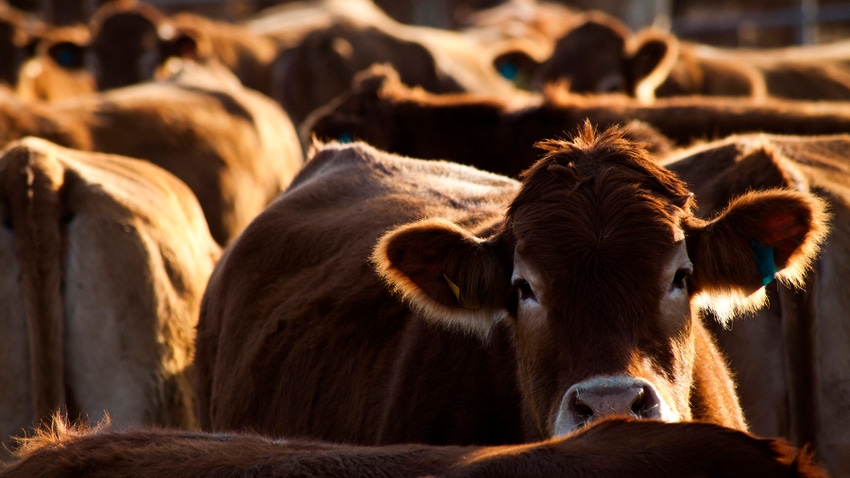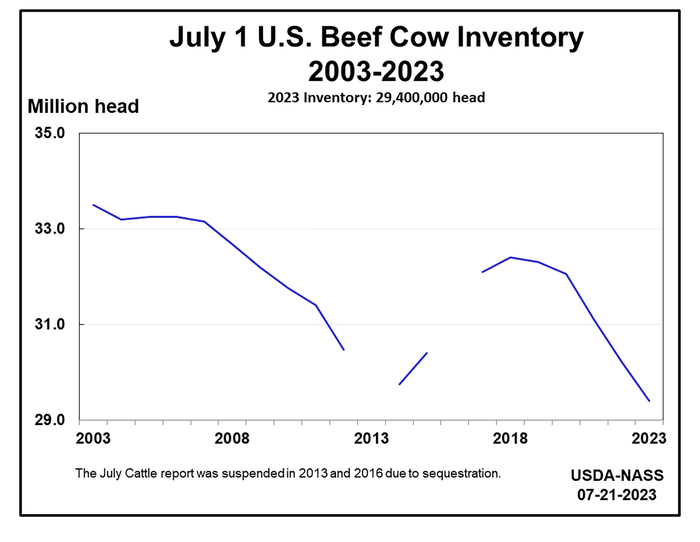August 11, 2023

At a Glance
- Overall cattle inventory down 3%, lowest since 2014
- Beef cow inventory lowest on record
- High input costs, drought contributing to reduced herds
Beef cattle inventories in the United States are at record low numbers, according to a U.S. Department of Agriculture report issued earlier in July.
USDA’s Cattle Inventory report, released each July, gives a snapshot of the cattle industry on a national scale. A similar report, released each January, breaks numbers down on a state-by-state basis. According to the most recent report, the U.S. cattle industry in aggregate has reduced its inventory by 3% to 95.9 million head, the lowest since 2014.
The inventory of beef cows in particular fell to 29.4 million head, 3% lower than the January 2022 inventory and the lowest number on record since 1971, when USDA began collecting such data.
James Mitchell, extension livestock economist for the University of Arkansas System Division of Agriculture, said the overall decline in inventory was expected, propelled by two well-known factors: the high cost of production and drought.
“It seems like every time drought abates in one part of the country, it pops up somewhere else,” Mitchell said. “Two years ago, we had a terrible drought in the western part of the country — Colorado, Montana, Wyoming. Last year that drought moved over the plains states, from North Dakota all the way down to Texas. Currently, that drought has moved either farther east, so it’s hitting Missouri and Iowa.
“It’s shifted east, and impacted producers’ ability to retain heifers and to grow their herds,” he said.
Drough effects
Arkansas producers, while more or less in the same fight as everyone else, have at least managed to avoid the worst of the country’s drought effects, Mitchell said.
“Knock on wood, we’re pretty fortunate in the southeast right now, in that we have largely avoided multi-year long-term drought, while other parts of the country haven’t been so lucky,” he said.

Beef Cows: Inventory on July 1 by Year for the United States. (Image courtesy USDA)
While rising market prices will typically spur an increase in herd inventories — 2023 has seen remarkably high prices for beef, rising more than 25% above 2022 numbers — high input costs have largely undercut that impulse, Mitchell said.
Rebuilding herds
“Higher prices generally mean that people should think about rebuilding their herds,” he said. “But we don’t make decisions based on prices, we make decisions based on profit. Currently, we’re seeing prices we haven’t seen since 2014, 2015 — but then, those higher prices translated to higher profits, because we weren’t battling the high input cost situation that we are today.
“We’re not going to see the same rate of expansion that we saw 10 years ago, because the profits aren’t there,” he said. “I think we’re going to see higher prices for a sustained period of time because nationally, the profits aren’t there for us to start building back herds.”
Mitchell said that in the current economic climate, profitability will hinge on producers’ efficiency.
“When you’ve got high cattle prices, the profits are going to go to those who are best at managing their costs,” he said. “If you can manage those correctly, there are profits to be made.”
Source: University of Arkansas System Division of Agriculture
About the Author(s)
You May Also Like






